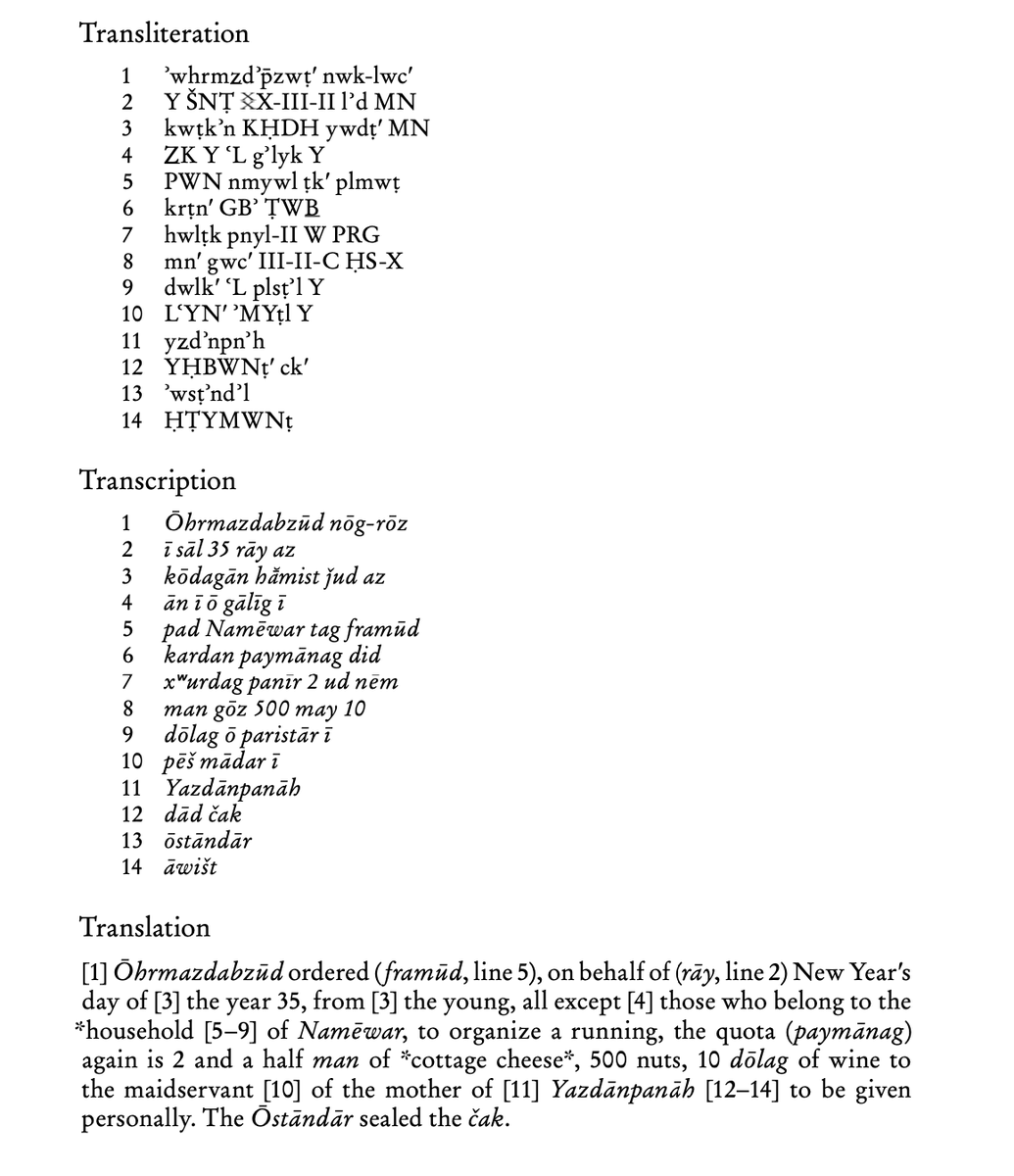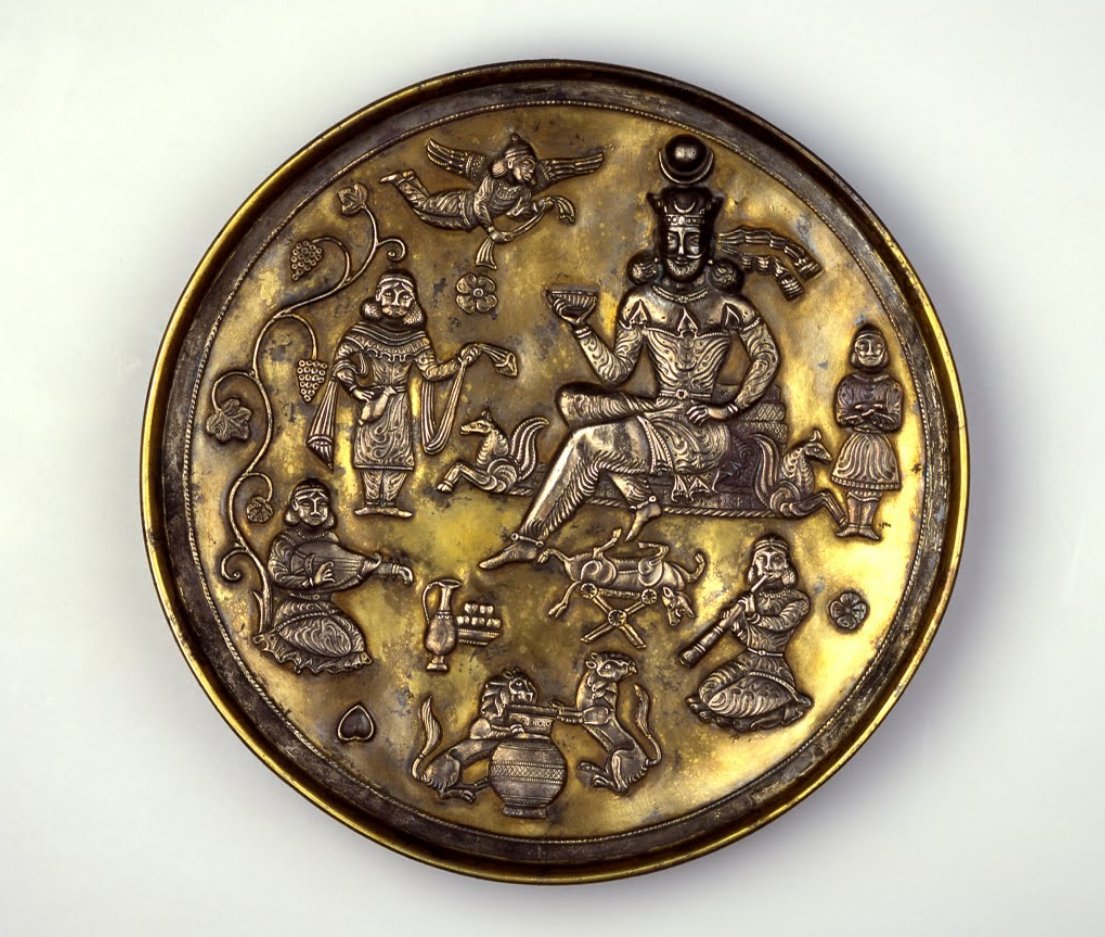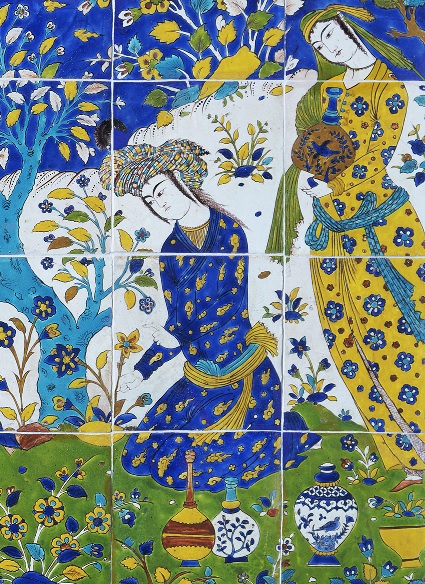
#Nowruz (Nouruz, نوروز, Наврӯз, MP: Nōgrōz) 🌸
Iranian New Year traditions in ancient Iran, especially Sasanian era, based on newly published papyri & other sources
نوروز در زمان ساسانیان: بر اساس پاپیروس های تازه منتشر شده و منابع دیگر
⤵️🧵
Iranian New Year traditions in ancient Iran, especially Sasanian era, based on newly published papyri & other sources
نوروز در زمان ساسانیان: بر اساس پاپیروس های تازه منتشر شده و منابع دیگر
⤵️🧵

I previously wrote on sources mentioning "nogruz" or Nowruz, as well as some of Nowruz' history:
For more, also see Iranica articles for traditions both before & after Sasanian era: iranicaonline.org/articles/nowru…
⤵️
https://twitter.com/On_Persia/status/1636040055897702405?s=20
For more, also see Iranica articles for traditions both before & after Sasanian era: iranicaonline.org/articles/nowru…
⤵️
Generally, we see great continuity in various aspects of Nowruz celebrations. We can say it was, like other feasts & major celebrations, about preparing for the feast & with very ancient Indo-Iranian roots
Like other feasts, there was merriment & food, as there is today
⤵️
Like other feasts, there was merriment & food, as there is today
⤵️
Manichaean text, with MP writing:
āmad nōg rōz ud nōg *šādī. āmad nōg rōz, awar-ā nōg *šādīh. āhār winnār ī zīndagān purr šādī
آمد نوروز و نوشادی/آمد نوروز، بیا نوشادی/خوراک آرای که زندگان پُرشادی
Nowruz came and new happiness... Nowruz came, come happiness... bring food
⤵️

āmad nōg rōz ud nōg *šādī. āmad nōg rōz, awar-ā nōg *šādīh. āhār winnār ī zīndagān purr šādī
آمد نوروز و نوشادی/آمد نوروز، بیا نوشادی/خوراک آرای که زندگان پُرشادی
Nowruz came and new happiness... Nowruz came, come happiness... bring food
⤵️


as life is full of joy... [my bad translation!].
So we gather there was lots of food (and desserts during Nowruz), as there is today.
Now it's difficult to be certain about the interpretation of newly published (in English) papyri from less than a 100 years after Sasanian era
So we gather there was lots of food (and desserts during Nowruz), as there is today.
Now it's difficult to be certain about the interpretation of newly published (in English) papyri from less than a 100 years after Sasanian era
By Weber (see: Sasanian Festivals in the Documents from the “Pahlavi Archive”, 2022)
But there are some intriguing parts!
The dating of these makes them very Important in understanding #Nowruz in #Sasanian era: they are from around second half of the 7th to beginning of 8th C

But there are some intriguing parts!
The dating of these makes them very Important in understanding #Nowruz in #Sasanian era: they are from around second half of the 7th to beginning of 8th C


See: New Arguments for Dating the Documents from the "Pahlavi Archive", Weber, 2008: jstor.org/stable/24049245
They are from central Iran, around the city of Qom
In Papyrus 1, we read in part: "...New Year′s
day of [3] the year 35, from [3] the young... of Namēwar...
They are from central Iran, around the city of Qom
In Papyrus 1, we read in part: "...New Year′s
day of [3] the year 35, from [3] the young... of Namēwar...

to organize a running"
According to Weber: Line 5: ṭk′tag, lit. ‘running’, here possibly a ‘(horse) race’.
This is very important, and could be linked to current sports & games played in Afghanistan (Khorasan) & Tajikistan among other places, like Buzkashi
⤵️
According to Weber: Line 5: ṭk′tag, lit. ‘running’, here possibly a ‘(horse) race’.
This is very important, and could be linked to current sports & games played in Afghanistan (Khorasan) & Tajikistan among other places, like Buzkashi
⤵️

As far as I know, this is the first time these papyri are being analyzed, as Weber did not give detailed commentary on them in 2022.
We further read in Papyri 1 on Nowruz: "2 and a half man of *cottage cheese*, 500 nuts, 10 dōlag of wine to the maidservant [10] of the mother
We further read in Papyri 1 on Nowruz: "2 and a half man of *cottage cheese*, 500 nuts, 10 dōlag of wine to the maidservant [10] of the mother

of [11] Yazdānpanāh [12–14] to be given personally."
We have mention of cheese (possibly "curds"), nuts, and wine! It's very interesting that Mary Boyce in the Iranica article mentions "a mirror with a lamp before it, a green-wrapped sugarcane, a pitcher full of curds..." from..
We have mention of cheese (possibly "curds"), nuts, and wine! It's very interesting that Mary Boyce in the Iranica article mentions "a mirror with a lamp before it, a green-wrapped sugarcane, a pitcher full of curds..." from..
celebrations in India. For the best wines in Sasanian era from MP Khosrow and Ridak see this description
⤵️
⤵️

We know from later sources including رسالۀ المحاسن و الاضداد ; and التاج في اخلاق الملوک (Taj), from around Abbasid period, of a number of Sasanian Nowruz traditions as well.
One of those is presentation of 7 legumes to the king with various traditions. There could be a link
One of those is presentation of 7 legumes to the king with various traditions. There could be a link
between this tradition and Haft Mēwa (هفت میوه, lit. seven fruits) in Afghanistan which includes raisins, Senjed (the dried fruit of the oleaster tree), pistachios, hazelnuts, prunes (dried apricots), walnuts and either almonds or another species of plum fruit
⤵️
⤵️

although it appears "haft seen" in Iran is of later origin
In Tajikistan & Afghanistan today there are other sports played during Nowruz, including wrestling, running* (exactly like papyrus!), & more modern sports
Photos: Sasanian & Sogdian wrestling, & 4: ancient Luristan
⤵️



In Tajikistan & Afghanistan today there are other sports played during Nowruz, including wrestling, running* (exactly like papyrus!), & more modern sports
Photos: Sasanian & Sogdian wrestling, & 4: ancient Luristan
⤵️




So far we've learned from papyrus 1 from about 50 years post-Sasanian era, and we can conclude the same traditions applied in Sasanian era:
Running (and presumably other sports, games & contests) organized for Nowruz
Various foods including curds/cheese, drinks including wine
Running (and presumably other sports, games & contests) organized for Nowruz
Various foods including curds/cheese, drinks including wine
از پاپیروس ۱۴۲ در امریکا میشه این برداشت رو کرد که در جشنهای نوروزی انواع خوراک و شراب وجود داشته و مسابقه هایی برای تفریح مانند دویدن. امکان داره ورزش ها و بازیهای دیگه هم اون وقت در ایام نوروز اجرا میشدن...
میدونیم که نوروز جشنی بسیار مهم بوده و مطمئنا موسیقی و پایکوبی
میدونیم که نوروز جشنی بسیار مهم بوده و مطمئنا موسیقی و پایکوبی
هم جزو رسوم بوده.
Papyrus 2: we read in part: "mother of Xusrōyān receives... the clothing of Xusrōyān on New Year′s day...
This one is dated 688/89 CE. The Sasanian empire fell gradually, but we can say roughly around 651 CE
This is less than 40 years later!!
⤵️

Papyrus 2: we read in part: "mother of Xusrōyān receives... the clothing of Xusrōyān on New Year′s day...
This one is dated 688/89 CE. The Sasanian empire fell gradually, but we can say roughly around 651 CE
This is less than 40 years later!!
⤵️


We continue reading: "she receives the garment in advance, [5] and on presenting the acknowledgement also this for me, [6] viz. a pair of comfortable shoes and a pair of trousers and for [7] one shirt 1 man of cotton..."
It's not clear if this is evidence of gift giving
⤵️
It's not clear if this is evidence of gift giving
⤵️
and also evidence of wearing new clothes for Nowruz, both still traditions in greater Iran.
It does appear to be evidence of new shoes, trousers, shirt etc. for new year's day. This is also very important evidence of Sasanian traditions
⤵️
It does appear to be evidence of new shoes, trousers, shirt etc. for new year's day. This is also very important evidence of Sasanian traditions
⤵️
Papyrus 3: there are 3 papyri with mention of Mehregan, the other important Iranian & Zoroastrian festival.
Here I will include one with specifics. We see that celebrations have some overlap with Nowruz and so we can use some of this info for #Nowruz as well
⤵️

Here I will include one with specifics. We see that celebrations have some overlap with Nowruz and so we can use some of this info for #Nowruz as well
⤵️


"wife of Xwarin [2] this month Mihr (7th month) of the [3] year 48 (699/700 ce) [4] on behalf of (rāy, line 5) the Mihragān celebration by the mother of [5] Xusrōyān the quota [6–8] again is 2 man of *cottage cheese*, 5 kabīz of *beans, [9–10] 500 nuts, 5 dōlag (pails) of wine"
We again see mention of "cottage cheese": curds, beans, nuts, and wine.
همچنین ما ممکنه رد پای رسم لباس نو پوشیدن و هدیه دادن رو در پاپیروس دیگری ببینیم؛ و اشاره به آجیل, حبوبات و می.
⤵️
همچنین ما ممکنه رد پای رسم لباس نو پوشیدن و هدیه دادن رو در پاپیروس دیگری ببینیم؛ و اشاره به آجیل, حبوبات و می.
⤵️
We can also assume Khāne-takānī (خانهتکانی): spring cleaning of house as part of Nowruz preparations from ancient times.
Form Denkard, book 3, and Shahnameh we learn generally about merriment & celebration during Nowruz, and "می و رود و رامشگران": wine, music and singers
⤵️

Form Denkard, book 3, and Shahnameh we learn generally about merriment & celebration during Nowruz, and "می و رود و رامشگران": wine, music and singers
⤵️


From Denkard we further learn: "men perform good deeds (on the day). On the occasion of this Jashan, men who work (for their living) hope for rest (i.e. observe it a day of rest) enjoy happiness and find comfort."
and "During the glorious and immortal period (of the intercalary
and "During the glorious and immortal period (of the intercalary
month) large quantities of food are exchanged among men... Men should not (during the period) harm animals which should be cared for."
So another aspect is rest, a holiday period, which we learn from other sources was the case during Sasanian era & later eras to this day
⤵️
So another aspect is rest, a holiday period, which we learn from other sources was the case during Sasanian era & later eras to this day
⤵️
From the 9-10 C CE Abbasid cookbook with Sasanian background we learn at least one cookie was used during feasts: khushk Nānak: خشک نانک
"filled pastries pressed into concave wooden molds carved with geometric shapes. More traditionally, they were shaped into crescents to
⤵️
"filled pastries pressed into concave wooden molds carved with geometric shapes. More traditionally, they were shaped into crescents to
⤵️
resemble the crescent moon, which heralds the beginning of such feasts.”
“these cookies are especially baked for religious feasts and exchanged as gifts among relatives and friends (al- maqrizi 757).”
Here are recipes for this Iranian, Sasanian dessert
⤵️



“these cookies are especially baked for religious feasts and exchanged as gifts among relatives and friends (al- maqrizi 757).”
Here are recipes for this Iranian, Sasanian dessert
⤵️




Samanu: Samanak (سمنو; суманак) sweet paste made from germinated wheat is also very ancient and was used during Sasanian era
It is still used across many countries including Iran & Tajikistan
I talked about other food & dessert recipes in ancient Iran before
⤵️
It is still used across many countries including Iran & Tajikistan
I talked about other food & dessert recipes in ancient Iran before
⤵️

From Biruni (973-1050 CE): we learn of some traditions for Nowruz in India:
"In the first hour of the day they worship the sun and pray for happiness and bliss to the spirits (of the deceased). In the middle of the day they worship the sun again,
⤵️

"In the first hour of the day they worship the sun and pray for happiness and bliss to the spirits (of the deceased). In the middle of the day they worship the sun again,
⤵️


and pray for the resurrection and the other world... On the same day they make presents to each
other, consisting of precious objects and domestic animals... In the hour of the equinox they light fires in sacred places."
The connection to Frawardigan is also present in
⤵️
other, consisting of precious objects and domestic animals... In the hour of the equinox they light fires in sacred places."
The connection to Frawardigan is also present in
⤵️
other accounts, and possibly relates to cleaning the house, wearing nice and new clothing etc., to prepare for commemorating the souls of the ancestors.
Photos: post-Sasanian plates showing feasts with food, music, drinks etc.
⤵️

Photos: post-Sasanian plates showing feasts with food, music, drinks etc.
⤵️


From the Soltikoff Bactrian Silver Plate in Sasanian style now @laBnF we learn that person to the left could be representation of Nowruz, and person to right is rep of Frawardigan
see: A New Interpretation of the ‘Soltikoff ’ Bactrian Silver Plate in the Bibliothèque Nationale
see: A New Interpretation of the ‘Soltikoff ’ Bactrian Silver Plate in the Bibliothèque Nationale

By Grenet: academia.edu/24477623/Extra…
Grenet and those before him have interpreted this plate as depicting various Iranian & Zoroastrian festivals
⤵️

Grenet and those before him have interpreted this plate as depicting various Iranian & Zoroastrian festivals
⤵️


Even if some are not correct or accurate, we can see some aspects of celebration of festivals, including Nowruz: food, gift giving, incense burner for clearing the air, wearing nice clothes etc.
⤵️

⤵️


From the Sogdian Afrasiab murals we learn wearing nice clothes, visiting ancestors, and animal sacrifice
see: The Circulation of Astrological Lore and Its Political Use, 2018, Grenet
Also see: sogdians.si.edu/afrasiab-mural…
⤵️


see: The Circulation of Astrological Lore and Its Political Use, 2018, Grenet
Also see: sogdians.si.edu/afrasiab-mural…
⤵️



It has now been firmly established that animal sacrifice was common in ancient Iran, including in Sasanian era, so animal sacrifice could have been part of Sasanian festivities too (of course to later be eaten or donated/gifted to others)
See for example possible animal
⤵️

See for example possible animal
⤵️


sacrifice on the Sasanian bowl now @britishmuseum
Also see: The Offering to Satisfy the ratu (miiazda ratufrī): the Dual System of the Animal Sacrifice
in Zoroastrian Rituals, 2022, Cantera
⤵️
Also see: The Offering to Satisfy the ratu (miiazda ratufrī): the Dual System of the Animal Sacrifice
in Zoroastrian Rituals, 2022, Cantera
⤵️

In short, much has been written about Nowruz & its history. But the new papyri offer some of the earliest, most important evidence of its celebration in central Iran just after the Sasanian era
Photo: textile from Egypt, Cluny, with Sasanian clothing
⤵️
Photo: textile from Egypt, Cluny, with Sasanian clothing
⤵️

مانند سایر مباحث ایرانشناسی; ما از چیزی که فکر میکنیم بسیار بیشتر از ایران باستان اطلاعات داریم. به حرف منفی افراد ضد ایرانی و بدبین هیچ گوش نکنید و خود تحقیق کنید.
نوروزتان پیروز 🙏🙏🌸🌼
Photo: textile from Egypt, @ Abegg-Schiftung
نوروزتان پیروز 🙏🙏🌸🌼
Photo: textile from Egypt, @ Abegg-Schiftung

• • •
Missing some Tweet in this thread? You can try to
force a refresh

























